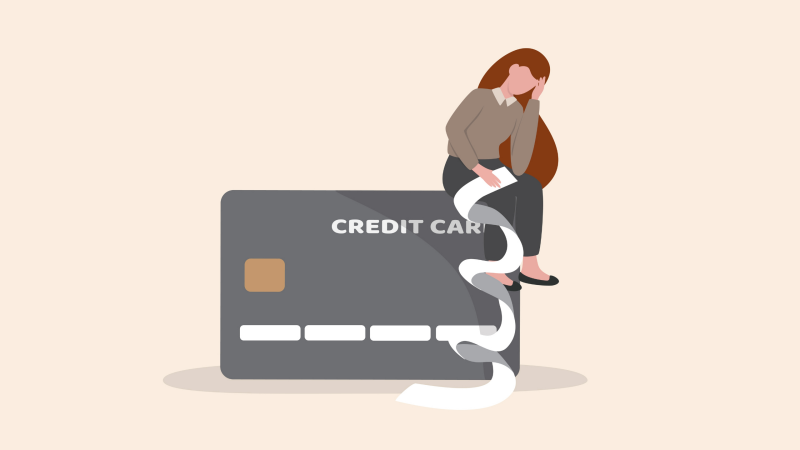What is a debt-to-credit ratio and why is it important?

Quick insights
- A debt-to-credit ratio is essentially the same as your credit utilization ratio, an important factor used to determine credit score.
- This ratio is important because it can help improve your credit score if you lower it to 30% and lower.
- Debt-to-credit ratio is different from debt-to-income ratio, which focuses on your monthly debt payments.
You may have heard of debt-to-income ratio, which can help lenders make a decision about financial agreements. However, there is also a debt-to-credit ratio, which is just as important because it is essentially the same as your credit utilization ratio, the total revolving credit you have used divided by the credit limit (available credit for you to use). This is a major factor considered when determining your credit score.
In this article, we’ll review:
- Debt-to-credit ratio
- Calculating your debt-to-credit ratio
- Debt-to-credit ratio and its impact on your credit score
- Debt-to-credit ratio vs. debt-to-income ratio
What is a debt-to-credit ratio?
Also known as your debt-to-credit rate, your debt-to-credit ratio is the ratio of how much credit you’re using against your total available credit. You can either calculate this ratio for a single credit card or combine all your credit cards and other lines of credit.
Here is the main difference between debt-to-credit ratio and debt-to-income ratio:
- Debt-to-credit ratio – this looks at your revolving credit (such as credit cards or lines of credit) against your total credit limit. This is the same as your credit utilization ratio.
- Debt-to-income ratio – this ratio considers your monthly debts (such as mortgages, loans, credit card debt, etc.) against your monthly income.
To help keep a healthy credit score, you may want to keep your debt-to-credit ratio (or credit utilization ratio) to about 30% or lower. You can see how factors like this impact your credit score when you enroll in Chase Credit Journey®, a free online tool where you can review your credit score and credit report provided by Experian™. Note that you do not need to be a Chase customer in order to use this tool.
How to calculate your debt-to-credit ratio
To calculate your debt-to-credit ratio for a single card, divide your balance for that credit card by the amount of credit available for that same card (the card’s credit limit). For example, if you have a credit card that has a total of $5,000 available credit and you use $2,500 of that credit, your debt-to-credit ratio would be 50%.
If you want to know your ratio against your total credit card limits, add up all your credit card balances and divide that number by the sum of the credit limits of all your credit cards. Another way to look at it is that you are dividing by the amount of debt you owe towards those lines of credit (these do not include things like installment loans or a mortgage, which is a fixed payment each month) by the amount of credit available to you.
For example, if you have a total amount of $10,000 available in credit across multiple cards, and you use a total of $3,000, your ratio would be 30%.
Debt-to-credit ratio and its impact on your credit score
So, why is it important to know this information? First off, your debt-to-credit ratio is a major factor when calculating your credit score. It counts as 20% towards your VantageScore® 3.0 credit score model and 30% of your FICO® score model.
Remember, it’s ideal to keep this ratio to about 30% or lower. This might show lenders that you are able to be responsible for how you manage your finances. For example, just because you have access to a total of $10,000 in credit card limits doesn’t mean you should use all of it. Tapping the entirety of your credit limit is not considered a sign of creditworthiness; in fact, it's the opposite. You want to be able to demonstrate to potential lenders that you aren't maxing out your credit cards each month to show you can budget effectively (only using 30% of available credit).
If you’re looking to improve your credit score, lowering your credit utilization ratio may be a good place to start.
Debt-to-credit ratio vs. debt-to-income ratio
Debt-to-income ratio considers different factors and is calculated by dividing your reoccurring debt by income (by the month). You may have to pay a monthly fixed amount of $1,000 in debt towards a loan and you have an income of about $2,000 each month. In this case, the debt-to-income ratio is 50%, which is considered high for many lenders. For context, around 43% is the highest acceptable ratio to take out a mortgage.
Remember, your debt-to-income ratio looks at the debts you have accumulated on a regular monthly basis (such as loans), while your debt-to-credit ratio considers revolving lines of credit, like credit cards or lines of credit (such as a home equity line of credit).
In summary
Both your debt-to-credit ratio and debt-to-income ratio are important factors when it comes to your financial wellness. At the end of the day, it’s important to manage your finances in a way that allows you to use your credit cards responsibly and not to max them out. This will help put you in a position to achieve your financial goals.



